Sledding in the Desert
White Sands National MonumentMonday&Thursday May 7th & 10th, 2007
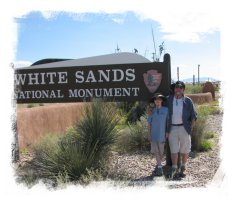
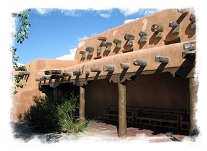
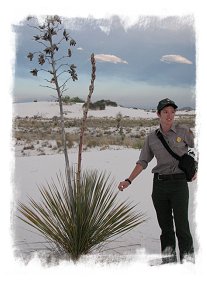
Each evening at 6:45 there is a Ranger led ‘Sunset Walk’, where you are led up into the dunes. Ranger Holly gave a wonderful talk on the geology of the park (how the dunes were created), and we learned quite a bit about how plants have adapted to live in such a harsh environment. Of particular interest were the Soaptree Yucca (the
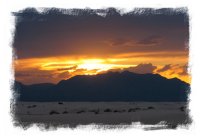
Finally, the highlight was sunset itself. With the sun setting over the San Andreas Mountains to the west, and shining colorfully on the Sacramento Mountain range to the east, it was spectacular. Other than the sound of the wind, the dunes are quiet. Many people come out to the dunes just to sit and watch the sunset.
White Sands is unique – there are only two other places in the world with the white gypsum sand dunes, and they are both much smaller. If you are interested in the geology, look here for a kid friendly explanation. Otherwise, suffice it to say that it has to do with Gypsum eroding from the nearby mountains into a basin with no rivers that drain it. When it rains, large shallow ponds form, which ultimately evaporate, leaving the gypsum. Through a combination of factors, this eventually winds up as sand, which is blown by the wind into the dunes.
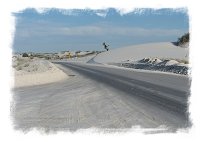
The Park Service has to plow the main road through the dune area of the park constantly with a snowplow. Eventually the dunes, which are in constant, although slow, movement, will cover the roads to the point where they have to be moved. Everything in the dunes is portable – buildings, amphitheaters, boardwalks, etc. Our guide, Ranger Holly stressed …..”The dunes are always going to win. So we don’t fight it.”
The Park Service puts an emphasis on desert safety – in the Junior Ranger Program, the exercise on do/don’ts while in the park was required, and thorough. Although the dunes look harmless, they aren’t. Recently a man died on a hike – shirtless, and without water, he died from heat exhaustion. The hike was only 4 miles long, which seems incredible that someone could get overheated in that short of a distance, but it happens.
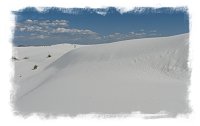
One of the big factors they stress is it’s easy to get lost. The dunes look much the same, with the undulating white sand stretching in every direction once you get back off the road a little bit. This is one of the very few Park Service facilities where you aren’t limited where you can walk – it’s all open. The problem is ~ there aren’t any real landmarks other than plants. If a sandstorm starts blowing and you lose your references, such as the sun and surrounding mountain ranges, it is very easy to get turned around. The Rangers constantly ask for help from the U.S. Border Patrol to find people who have gone missing in the dunes, using some of the high tech equipment the Border Patrol has for detecting illegal immigration attempts.
If the wind kicks up, you can get in real trouble. The wind has to blow above about 15mph in order to disturb and blow the sand. However, it can get a lot windier than that, and when it does, you can get a whiteout from the pure white gypsum blowing around.
We were shopping in Alamogordo one afternoon, nearly 15 miles away, when a sandstorm kicked up. In just a matter of minutes the entire city looked to be in a white cloud. It felt like being sandblasted, and we all had gritty white particles on us when we got back to the camper. Looking back toward the park, all you could see was a billowing cloud of white. Not something I’d want to get caught in.
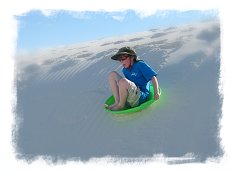
We came back a couple of days later on a bright and sunny day for Vance to play on the dunes. They range from 15-20 feet high, and are fun to sled down. The gift shop at the
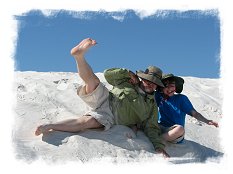
We had a grand old time – Vance and I would tackle each other and roll down the dunes, turning the both of us pearly white! We spent a good part of the afternoon playing in the sand, and just goofing off. Denise earned her keep as the water girl and photographer.
The park has Holloman Air Force Base on one side, and the

Vance: White Sands is very nice and fun. The sand was made of the mineral gypsum. This was all formed by water millions of years ago. There are many plants and animals that live in the monument. A lizard called the Bleached Earless Lizard does a pushup when he is out in the night.
The first day we did a sunset hike. The ranger told us about how the dunes were formed and the wildlife. Some plants form around piles of sand called pedestals. It is so hot in the day, most animals come out in the cool evening.
You might be surprised by the following!
IF YOU GET A LITTLE DISK SLED, YOU CAN SLED DOWN THE DUNES!
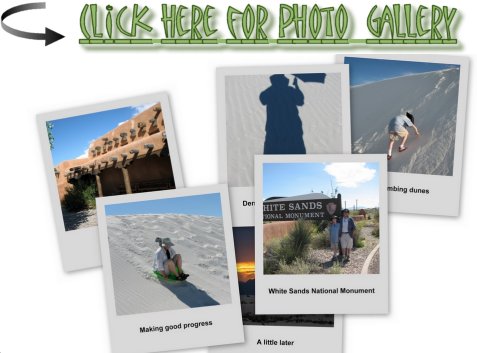
| Prev - New Mexico Space Museum | | Home | Index | | The Gift ... - Next |







<< Home